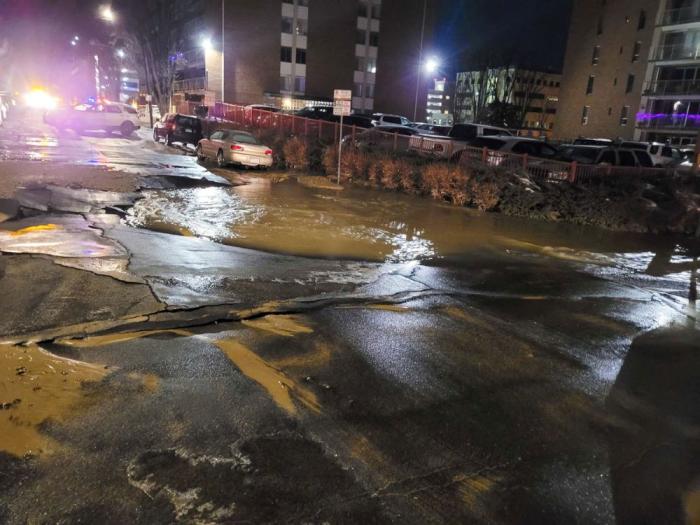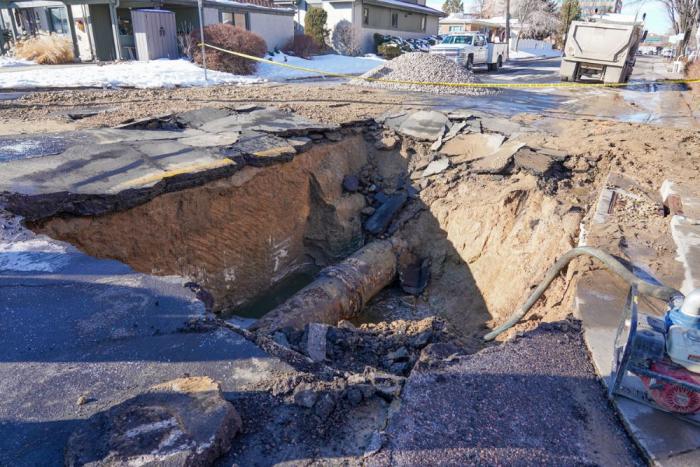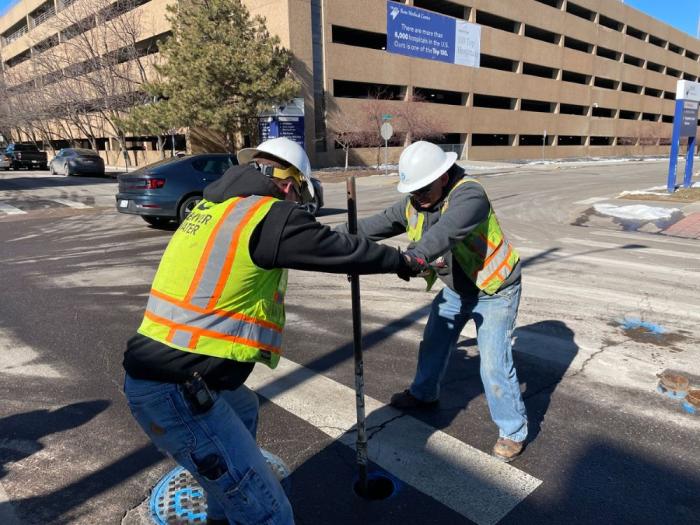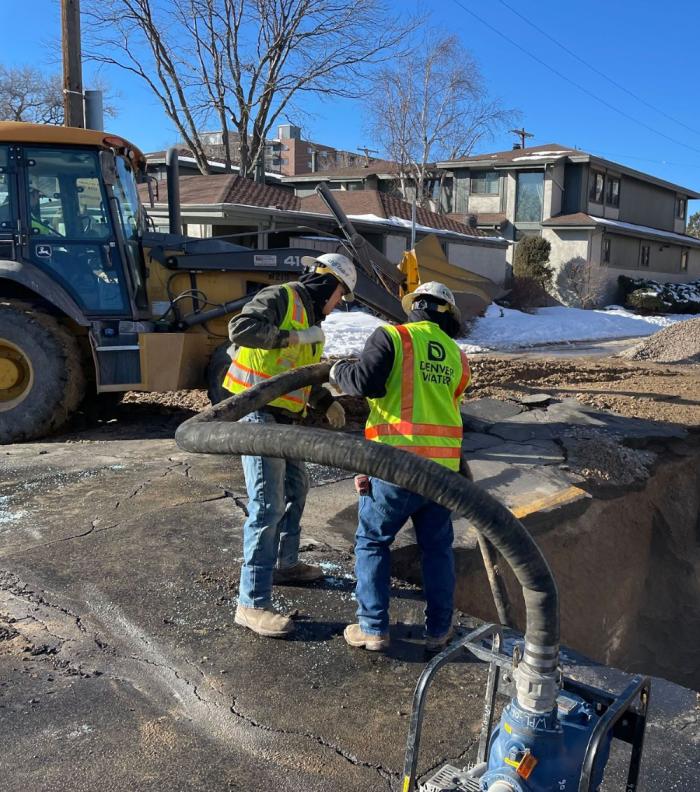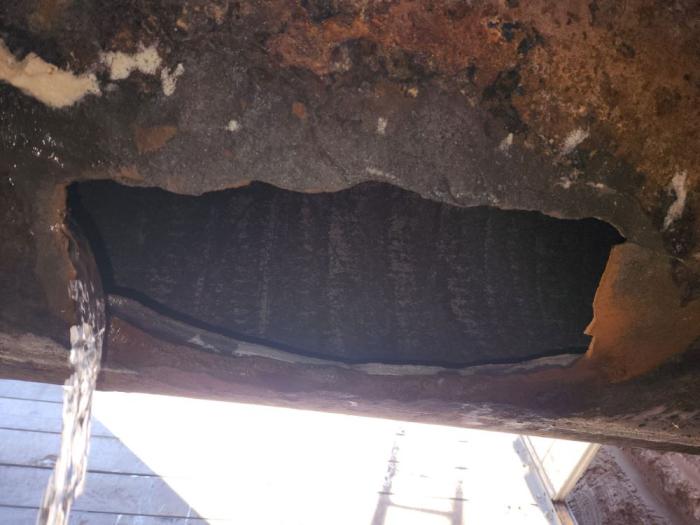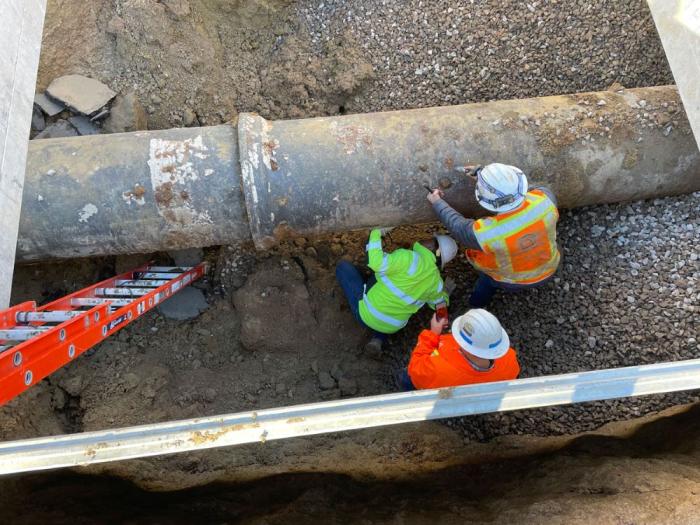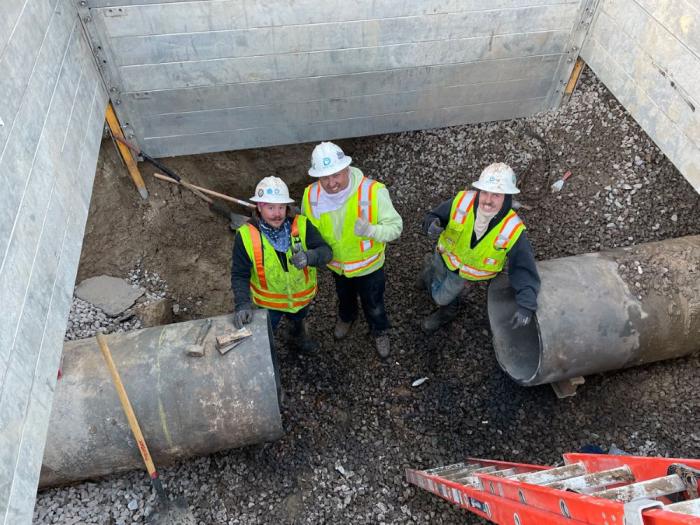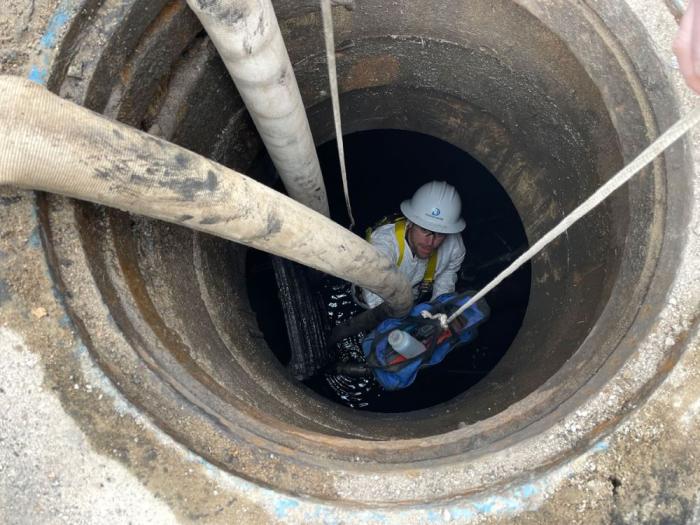How our crews respond to a water main break
No one wants to see water flowing down a city street from a broken water pipe. It can cause plenty of disruptions in a neighborhood.
That’s why Denver Water proactively invests in its water delivery system to keep pipe breaks below the industry benchmark of 15 breaks per 100 miles of pipe per year.
But even though the utility is below that industry benchmark, with roughly 12.5 breaks per 100 miles of pipeline per year, Denver Water crews respond to more than 300 ruptures annually.
Did a friend forward this to you? Sign up for TAP’s free weekly email. (Scroll down to put your email in bar.)
When pipes do break, Denver Water activates its robust emergency response process to act immediately and restore service to the impacted community as quickly and safely as possible.
To help understand the process of repairing a broken water line, we’ve put together a timeline of what happened when a large water pipeline broke in Denver earlier this year.
Around 3 a.m. that day, Denver Water’s 24/7 dispatch center received a call about water on the street.
Within 15 minutes, Joel Morales from Denver Water’s emergency services team was on his way to check out the report.
“When we got there it looked like a river of water on the street, and I knew it was probably a big pipe that broke,” Morales said.
The pipe that had broken is known at Denver Water as Conduit 45, a 30-inch cast-iron pipe.
Temperature swings can be tough on pipes.
Conduits are Denver Water’s larger, underground transmission pipelines that carry large amounts of water across the city.
Breaks on these larger pipes are rare, as most breaks occur on the smaller pipes that range from 6 inches to 12 inches in diameter and carry water beneath city streets from the conduits to customer service lines.
“I’ve been doing this job for 30 years and this is only the third conduit break I can remember getting called out on,” Morales said.
According to Morales, when a member of the emergency services team arrives at the site of a pipeline break, the first priority is to locate the valves under the street that are connected to the pipeline and to turn those valves to stop water from flowing to the ruptured area.
In the case of large conduits connected with other pipes, emergency services teams may have to turn dozens of valves before stopping the flow of water. Morales said the team starts with the valves closest to the rupture and works its way further down the pipe.
Morales said it can take several hours to turn off enough valves to slow most of the flow of water from a ruptured portion of a pipe. This is due to the maze of interconnected pipes under the ground. Another issue can be old valves that may not shut completely.
Fixing the pipe
Once the flow of water to the pipeline is turned off, the next step in the repair process is to get water out of the hole in the road that was caused by the ruptured pipe.
For this break, a crew led by water distribution supervisor Ed Romero arrived on scene to tackle this job and begin the repair process.
“We needed to get the water out so we could get in the hole to fix the pipe,” Romero said. “With big breaks, there can be a lot of water to pump out and it can take several hours.”
Once water was drained from the hole, Romero’s crew then dumped rock into the hole to make it easier to work on the muddy ground surrounding the pipe.
The next step involved building a large shoring box, which is a safety device used to prevent unstable ground from giving way on the sides of the hole when crews are working in the hole. Large holes require boxes, while smaller holes can be stabilized with braces.
“While we want to get down to start working on the pipe right away, safety comes first. That’s why we take the time to assemble the shoring box and put it in the hole,” Romero said.
For this break, the shoring box was put in place around 2:30 p.m., nearly 12 hours after the call reporting water on the street came into Denver Water’s dispatch center.
With the shoring box in place, Romero; Aaron Arguello, a Denver Water water distribution manager; and Antonio Flori, a corrosion engineer for Denver Water, could go into the hole to inspect the pipe.
Following the inspection, Arguello and Romero decided that the best course of action to repair the break was to cut out a 6-foot section of the pipe and replace it with a new piece.
Roughly 12 hours after the first crews arrived on scene, Denver Water crew members entered the sinkhole and began the challenging task of fixing the ruptured pipeline.
Armed with two 25-pound saws with 14-inch, diamond-tipped blades, Denver Water utility technicians Garett Alford, Ray Ramirez and Jacob Wren climbed down a ladder into the hole to cut out a 6-foot section of the cast iron pipe.
Repairing pipelines is challenging work that requires precision, heavy lifting and teamwork. Crews made three cuts in the ruptured pipeline and then used an excavator to lift the damaged section out of the hole.
“We usually do repairs on pipes that range from 6 to 12 inches in diameter,” said Garett Alford, a senior utility technician at Denver Water. “I’d seen pipes this big before, but this was the first time I’ve actually repaired one, so I was looking forward to the challenge.”
Alford said the team uses the same techniques to repair a 30-inch pipe as they do on smaller ones.
“The size of the pipe didn’t really phase us, but it was still a challenge and actually pretty cool to work on,” he said.
“Our goal is to protect against corrosion, one of the main reasons that pipes break.”
Once the damaged section was removed, the team installed special connector rings, known as megalug flange adaptors, and pipe sleeves onto both ends of the ruptured pipe.
Crews lowered a new section of pipe into the hole and then carefully slid it into place and bolted it to the sleeves and brackets.
“It was fun to work on this one; I have great teammates and now we can say we’ve fixed a pipe this size,” Alford said.
By 10 p.m., less than 24 hours after the first report that water could be seen on the street, another Denver Water crew had arrived on site to wrap up the repairs and fill the hole with dirt.
Putting pipes back in service
Before pipelines are put back into service after a break, a specialized Denver Water team is called out to check the quality of the water flowing through the newly repaired section of pipe.
The water quality experts start by flushing clean water through the pipeline to clear out any dirt. The team also conducts a series of tests to make sure the water is free of bacteria and meets all safe drinking water standards.
Disinfectants added to water at Denver Water’s treatment facilities provide an additional level of protection.
“This break was caused by corrosion on the bottom of the pipe, but the rest of the pipe appeared to be in good shape,” Flori said.
Denver Water will evaluate the pipeline and determine what led to the corrosion and whether a larger section of the pipeline should be replaced in the future as part of the utility’s pipe replacement program.
Being safe takes time
Denver Water has processes in place to ensure its crews can immediately respond to and repair pipeline breaks in all weather conditions, 24/7/365.
Yet while Denver Water’s crews can make repairs relatively quickly, ensuring crew members can safely access broken pipes can take time, explained Tim Mukoda, Denver Water’s manager of safety.
“Pipe breaks are unexpected events, and we can’t start digging or cutting right away,” Mukoda said. “We understand delays may be frustrating for residents, but we have to make sure a site is safe before our workers go into a trench.”
Prep work for repairs includes locating underground utility lines, taking out permits if required, setting up traffic control, installing trench shoring devices, moving parked vehicles, and creating a safe work area in a muddy pit.
Fortunately, in this case, no Denver Water customers were directly connected to the ruptured pipeline. That means no customers were without water due to the break during the time it took to repair the pipeline.
It did take several days for paving and restoration crews to fix the damage to the street and reopen the intersection where the pipe ruptured.
“It takes a lot of people and a lot of hard work to repair a broken pipeline and get it back in service,” Romero said. “The hours are long, and the work is tough, but it’s also challenging and rewarding knowing we provide such an important service to our community.”


